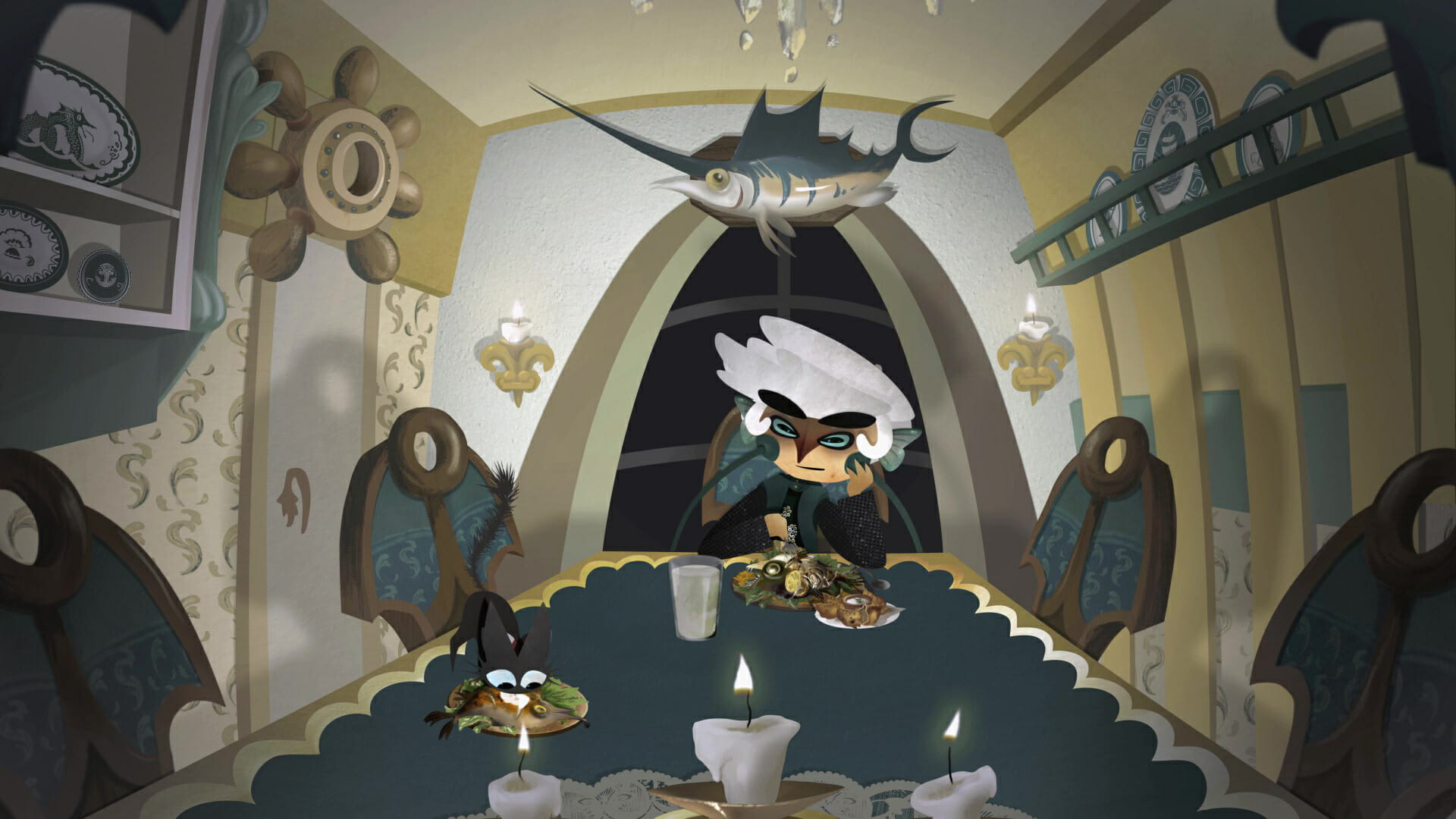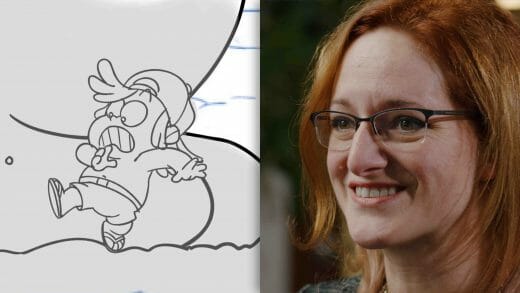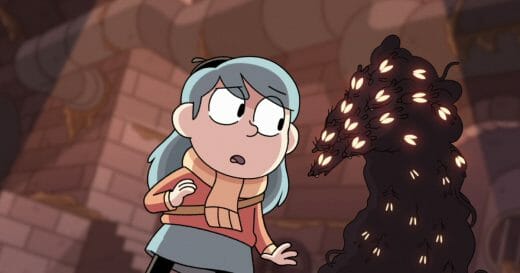
Fáros is an intriguing short film from Rayna Buxton; an animation student, character designer and filmmaker who makes striking use of textures. Telling the tale of a light-house keeper’s struggles, this charming story showcases a strange, in-between world that draws inspiration from oceanic mysteries like the Bermuda Triangle.
This narrative explores the symbiotic relationship between the light-house and its keeper; an allegory familiar to anyone who has nurtured a project, an idea, or a living being. Another important theme in Fáros is burnout, which Rayna explores through the growing weariness of her protagonist, Ori. The film displays elements of fantasy, myth and horror, all rolled into its short run-time.
Throughout the process of achieving her dynamic style, Rayna employed character design and animation techniques in Toon Boom Harmony Premium, such as rigging Ori using peg layers. The designs and animation draw from her research into the natural world, as well as influence from stop-motion animation. Read on to learn about how Rayna gets inspired, and how these influences fed into Fáros.
Congratulations on your visually striking short, Fáros! Please briefly introduce yourself…
Thank you so much! I’m Rayna Buxton and I’m a filmmaker with a focus on character design and animation. Currently, I’m attending my final semester at California Institute of the Arts. As a lover of nature and fantasy, I often work with nature spirits and mythical creatures in my art.
I grew up in Iowa. After moving to California, I felt a bit alienated by the differences in plant life and environment. I decided to do a film centered around the ocean, in order to connect more with California and the beauty it had to offer.
What can you tell us about the world that Fáros takes place in? How did you dream this up?
Fáros takes place in a sort of in-between world, where the human realm overlaps with another. The Bermuda triangle comes to mind. The lighthouse lives on unlucky ships that cross into that in-between space. I enjoy mixing the real world with fantastical elements: obnoxious seagull griffins, a ship-eating lighthouse that still needs to be cleaned and maintained, and its keeper; who is burned out and bored, despite the miraculous world around them.
When brainstorming, I will often create two lists: one of common environments in the human world, and one with words I find intriguing. Sometimes combining them can spark an idea. I believe the one for Fáros was: “lighthouse hunting.”
The lighthouse is very much a character in the film. Where did the idea come from?
The idea of the lighthouse character was the first thing that came to me when writing Fáros. I am inspired by Japanese Yokai. They are supernatural beings that are usually dangerous, some resembling everyday objects. I decided the lighthouse was a predatory hunter, disguised as a beacon of safety to lure in unsuspecting ships. From a person’s point-of-view, this short could have easily been horror, but I didn’t want the lighthouse to be seen as evil. It’s just a predator that needs to eat, like any other. That’s why I decided to use the non-human perspective, focusing on the relationships between the lighthouse and its inhabitants.
In Fáros, the keeper and the lighthouse need each other to live. Even in the real world, lighthouses and their keepers have a close symbiotic relationship, despite the building being inanimate. The job of a lighthouse keeper takes up a larger part of their lives than most. They have to constantly clean and perform maintenance. The lighthouse gives them a place to live, and they keep it ‘healthy.’ Fáros just takes it to the next level.
What was the research process behind the crab and other sea-life in Fáros?
Whenever you animate, it’s good to have reference. I watched many videos of crabs and seagulls. However, the way we picture an animal isn’t always accurate to its reality. Sometimes, changing elements of the motion or mixing in behaviors from other creatures can create animation that feels more like the creature, despite being inaccurate. For instance, seagulls don’t often flap their wings much; they glide more than anything else. I decided to give the seagull griffins a more sporadic flight pattern to make them seem chaotic.
The crab was inspired by multiple creatures. One was the sand crab, which buries itself in the sand to hide from predators. However, the lighthouse is probably closer to the northern stargazer – a fish that also buries itself, leaving only its eyes and mouth free. It waits in hiding until unsuspecting prey swims over; then it attacks.
The lighthouse keeper is an interesting looking character. Can you talk us through the character rigging process?
Ori’s animation was a hybrid of cut-out style rigging and drawn animation. Ori’s rig was created by parenting layers to pegs, and I had a head turn in a separate file from which I would copy and paste sections. Most of Ori’s animation was peg-based, but I would usually draw the pants and arms every frame to make them feel more natural, removing the lines for the final product.
The environment and characters in Fáros are made up of many interesting layers and textures. Can you talk us through how this style was achieved?
When developing the style, I wanted to create something inspired by stop-motion background, but in 2D. Thus, the result was a combination of rendered painting, photo textures, and paper cut-out lighting. I used Toon Boom Harmony to create the art, and either Krita or Photshop to overlay photographs that I had taken around my house for texture. For the characters, I then brought those images back into Harmony to animate. For the final look, each layer was rendered out and positioned in After Effects, where I added lighting and flat shadows that gave it a paper cut-out feel.
Although they are isolated, Ori never appears to be in danger. What were you trying to convey?
The feeling I was channeling for Fáros was burnout: You’re doing something you love, but you’ve exhausted yourself and can’t seem to connect with it in the way you usually do. It doesn’t give you the same joy it usually does and becomes more of a chore.
It’s something I experience regularly as an artist. It comes in cycles. It’s not fun, but there’s a sort of relaxed inevitability to it. You will get over it in time, and you will experience it again later. There’s nothing you can do but be a bit easier on yourself and wait it out.
Ori loves the lighthouse and the sea, but his life is fast-paced and repetitive. Only when the situation is completely out of his hands does he get the moment of stillness he needs to begin reconnecting with himself with the world.
Do you have plans to develop the characters and universe we see in Fáros?
While I don’t have any immediate plans, during production I received feedback that the world may lend itself nicely to a game. Because of the short’s slice-of-life feel, I have considered the possibility of an app that focuses on tasks around the lighthouse and home activities like decoration and cooking, in a similar vein to Animal Crossing.
What has it been like learning Toon Boom Harmony and having your work featured in the education showreel?
I’ve been working with Toon Boom Harmony since high school, and every time I try a new style I discover tools I didn’t know about before. There are so many ways to use the program. It was a pleasure to participate in the showreel and see the huge variety of work others had created, each in their own style. It is inspirational to see how everyone takes a different approach to using the tools in front of them.
Any last words or advice for our readers?
I am happy with the way Fáros turned out, but it wasn’t a smooth ride to get there. It went a year over my original deadline. When things don’t go as planned, it’s easy to want to abandon what you’re doing and move onto something else. However, you have to have faith in your original vision. There is a reason you set out to do that thing, and if it was worth the effort you already put in then it’s worth finishing. Whatever your goal is, stick to it, even if it gets rough. There’s a reason we’re drawn to the things we are.
- Fáros was featured in the 2022 Toon Boom Education Showreel, which you can watch here.
- Interested in seeing more work from Rayna Buxton? Be sure to visit her portfolio.
- Considering Harmony and Storyboard Pro for your thesis film? Learn about Toon Boom’s student licenses.



